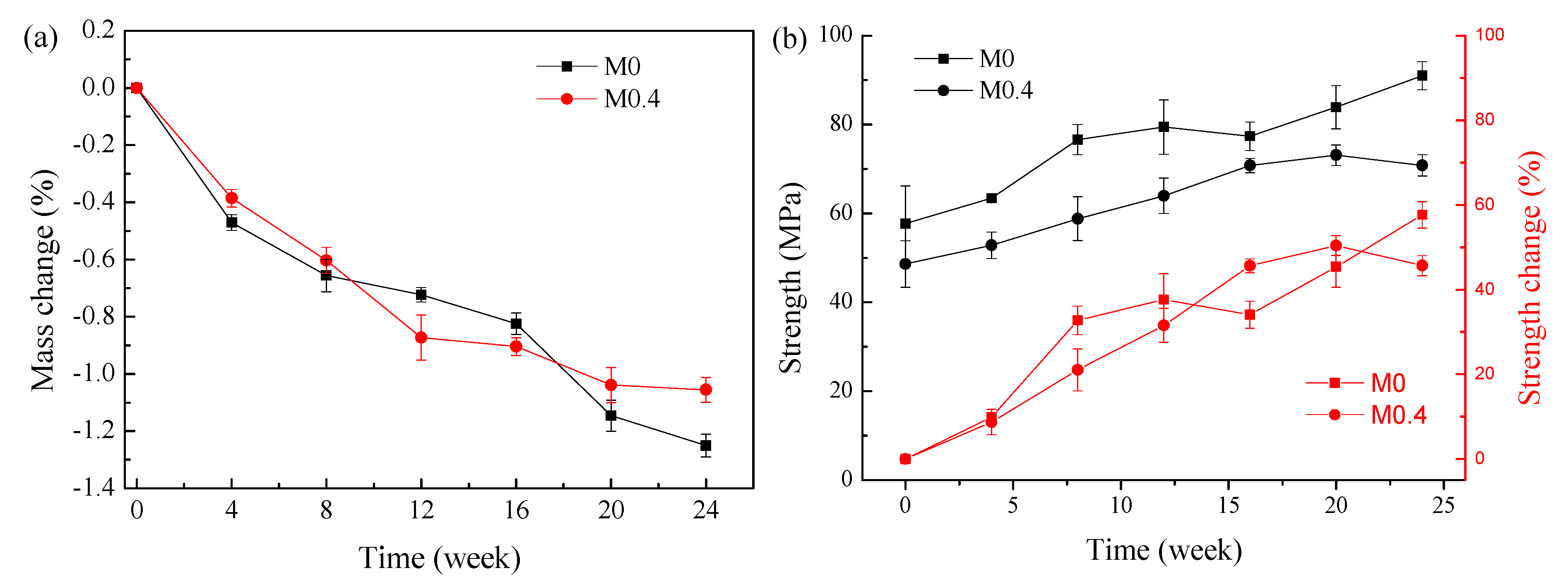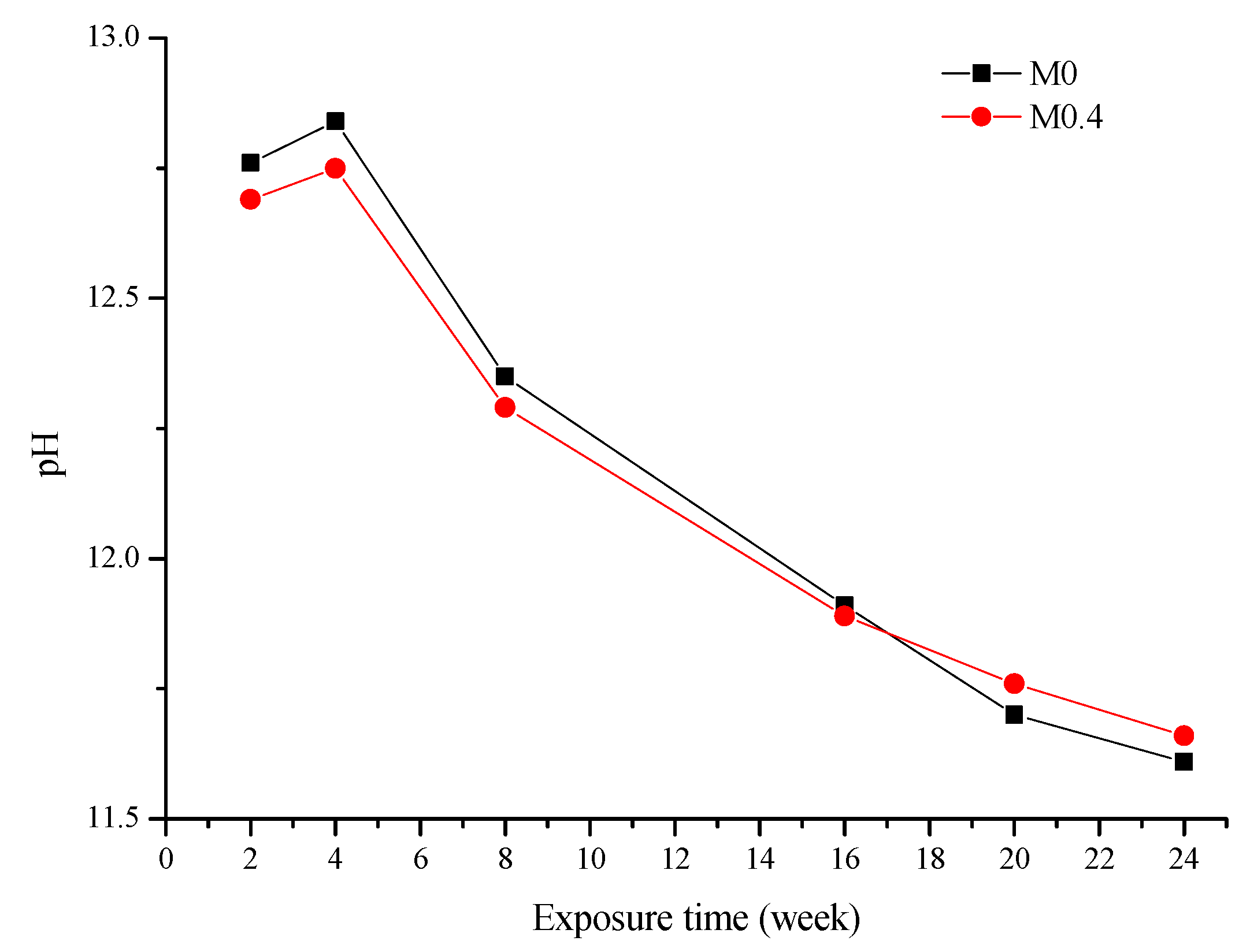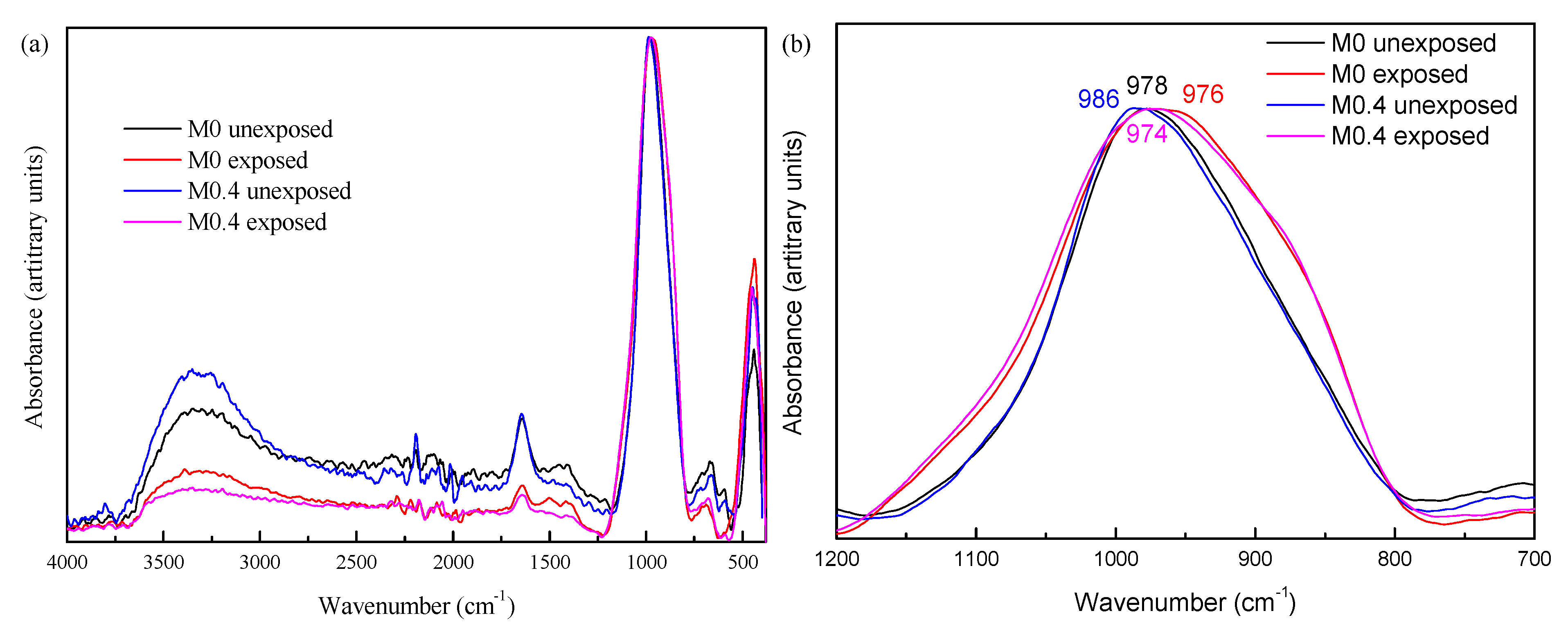Performance of Fe-Rich Alkali-Activated Materials in Na2SO4 Solution: Role of MgO/(MgO + CaO) in the Slag †
Abstract
:1. Introduction
2. Materials and Methods
3. Results and Discussion
4. Conclusions
Author Contributions
Funding
Institutional Review Board Statement
Informed Consent Statement
Data Availability Statement
Conflicts of Interest
References
- Habert, G.; Miller, S.A.; John, V.M.; Provis, J.L.; Horvath, A.; Horvath, A.; Scrivener, K.L. Environmental impacts and decarbonization strategies in the cement and concrete industries. Nat. Rev. Earth Environ. 2020, 1, 559–573. [Google Scholar] [CrossRef]
- Onisei, S.; Lesage, K.; Blanpain, B.; Pontikes, Y. Early Age Microstructural Transformations of an Inorganic Polymer Made of Fayalite Slag. J. Am. Ceram. Soc. 2015, 98, 2269–2277. [Google Scholar] [CrossRef]
- Komljenović, M.; Baščarević, Z.; Marjanović, N.; Nikolić, V. External sulfate attack on alkali-activated slag. Constr. Build. Mater. 2013, 49, 31–39. [Google Scholar] [CrossRef]
- Bernal, S.A.; Provis, J.L. Durability of Alkali-Activated Materials: Progress and Perspectives. J. Am. Ceram. Soc. 2014, 97, 997–1008. [Google Scholar] [CrossRef]
- Ke, X.; Bernal, S.A.; Provis, J.L. Uptake of chloride and carbonate by Mg-Al and Ca-Al layered double hydroxides in simulated pore solutions of alkali-activated slag cement. Cem. Concr. Res. 2017, 100, 1–13. [Google Scholar] [CrossRef]
- Siakati, C.; Douvalis, A.P.; Ziogas, P.; Peys, A.; Pontikes, Y. Impact of the solidification path of FeOx–SiO2 slags on the resultant inorganic polymers. J. Am. Ceram. Soc. 2019, 103, 2173–2184. [Google Scholar] [CrossRef] [Green Version]
- Wen, N.; Peys, A.; Hertel, T.; Pontikes, Y. The effect of the chemical composition of MgO-CaO-FeO-Al2O3-SiO2 slag on the reaction kinetics and compressive strength of alkali-activated materials. In Proceedings of the 7th International Slag Valorisation Symposium, Leuven, Belgium, 27–29 April 2021; pp. 270–275. [Google Scholar]
- Gong, K.; White, C.E. Nanoscale Chemical Degradation Mechanisms of Sulfate Attack in Alkali-activated Slag. J. Phys. Chem. C 2018, 122, 5992–6004. [Google Scholar] [CrossRef]
- Takahashi, T.; Maehara, I.; Kaneko, N. Infrared reflection spectra of gypsum. Spectrochim. 1983, 39, 449–455. [Google Scholar] [CrossRef]



| FeO | SiO2 | CaO | Al2O3 | MgO | MgO/(MgO + CaO) | |
|---|---|---|---|---|---|---|
| M0 | 48.0 | 34.0 | 10.5 | 7.5 | 0 | 0 |
| M0.4 | 49.0 | 33.0 | 6.5 | 7.5 | 4.0 | 0.4 |
| M0-AAM | M0.4-AAM | |||||||
|---|---|---|---|---|---|---|---|---|
| Na | Ca | Al | Si | Na | Ca | Al | Si | |
| Week 2 | 673 (52) | 4.0 (0.13) | 2.7 (0.14) | 21.0 (1) | 747 (63) | 1.3 (0.3) | 1.6 (0.02) | 17.2 (0.1) |
| Week 4 | 1275 (10) | 5.3 (0.8) | 3.1 (0.1) | 26.8 (0.1) | 1047 (77) | 1.4 (0.3) | 1.9 (0.02) | 22.4 (0.1) |
| Week 8 | 623 (66) | 13.2 (0.3) | 1.0 (0.01) | 8.4 (0.2) | 503 (71) | 5.5 (0.3) | 1.1 (0.07) | 12.1 (0.2) |
| Week 16 | 410 (60) | 25.1 (0.7) | 0.4(0.03) | 3.0 (0.2) | 487 (61) | 12.7 (0.2) | 0.5 (0.02) | 5.3 (0.2) |
| Week 24 | 340 (55) | 33.2 (0.7) | 0.4(0.01) | 3.3 (0.1) | 463 (59) | 16 (0.2) | 0.4 (0.01) | 4.2 (0.2) |
Publisher’s Note: MDPI stays neutral with regard to jurisdictional claims in published maps and institutional affiliations. |
© 2022 by the authors. Licensee MDPI, Basel, Switzerland. This article is an open access article distributed under the terms and conditions of the Creative Commons Attribution (CC BY) license (https://creativecommons.org/licenses/by/4.0/).
Share and Cite
Wen, N.; Peys, A.; Hertel, T.; Pontikes, Y. Performance of Fe-Rich Alkali-Activated Materials in Na2SO4 Solution: Role of MgO/(MgO + CaO) in the Slag. Mater. Proc. 2021, 5, 125. https://doi.org/10.3390/materproc2021005125
Wen N, Peys A, Hertel T, Pontikes Y. Performance of Fe-Rich Alkali-Activated Materials in Na2SO4 Solution: Role of MgO/(MgO + CaO) in the Slag. Materials Proceedings. 2021; 5(1):125. https://doi.org/10.3390/materproc2021005125
Chicago/Turabian StyleWen, Nana, Arne Peys, Tobias Hertel, and Yiannis Pontikes. 2021. "Performance of Fe-Rich Alkali-Activated Materials in Na2SO4 Solution: Role of MgO/(MgO + CaO) in the Slag" Materials Proceedings 5, no. 1: 125. https://doi.org/10.3390/materproc2021005125
APA StyleWen, N., Peys, A., Hertel, T., & Pontikes, Y. (2021). Performance of Fe-Rich Alkali-Activated Materials in Na2SO4 Solution: Role of MgO/(MgO + CaO) in the Slag. Materials Proceedings, 5(1), 125. https://doi.org/10.3390/materproc2021005125






